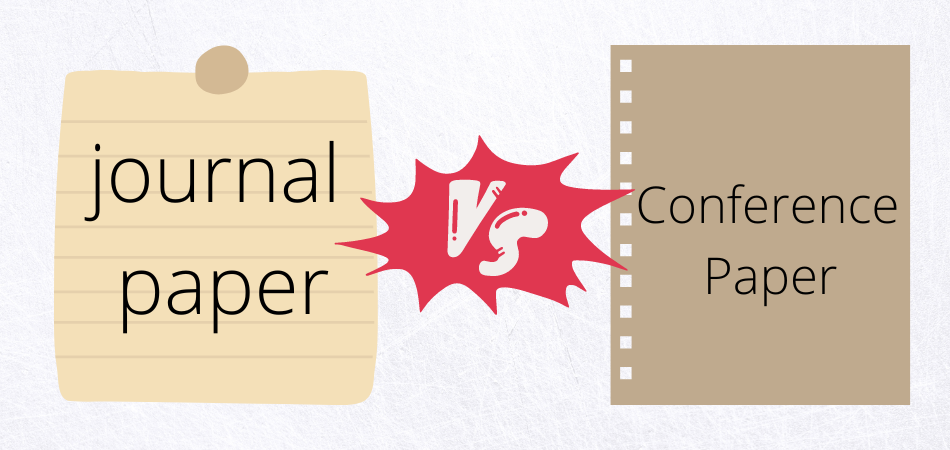Research papers play a crucial role in academia, aiding in disseminating new knowledge and advancing scholarly conversations. Two prominent types emerge within the realm of research papers: journal papers and conference papers. But what sets them apart?
While journal and conference papers serve as platforms for sharing research findings, they differ significantly in their publication process, evaluation criteria, and impact.
Journal papers undergo a rigorous review process, emphasizing in-depth analysis, while conference papers focus on current research and provide a platform for sharing preliminary findings.
This blog provides insights into “What is the difference between journal and conference paper?” By shedding light on this topic, we aim to help researchers make informed decisions regarding the most suitable publication avenues for their contributions to academia.
Definition And Characteristics Of Journal Paper
A journal paper is a scholarly publication undergoing a rigorous peer-reviewed process. It is published in reputable academic journals, signaling its credibility and adherence to academic standards.

These papers emphasize original research and academic rigor, ensuring the quality and validity of the findings. Furthermore, due to the extensive review process, journal papers generally have a longer publication timeline than conference papers.
Their inclusion in citation indexes and the measurement of their impact through factors like the impact factor further highlight the significance of journal papers in the academic community.
Structure And Content
A typical journal paper follows a well-defined paper structure to present the research coherently. It comprises sections such as an introduction, literature review, methodology, results, and analysis, and a conclusion and discussion.
Each section plays a vital role in conveying the research objectives, contextualizing the study within the existing literature, outlining the research methodology, presenting and interpreting the results, and drawing meaningful conclusions.
Thorough literature reviews and comprehensive analysis are essential for journal papers, as they contribute to the overall scholarly discourse.
Publication Process
Publishing a journal paper involves several steps, starting with submitting the manuscript to a journal. Once submitted, the paper undergoes a rigorous peer review process, wherein experts evaluate its quality, methodology, and significance.
Authors are required to make revisions and resubmit the paper based on the reviewers’ feedback. Final acceptance and publication occur after successfully addressing the reviewers’ comments. Publishing in reputed journals is important for researchers, enhancing their career prospects, recognition, and credibility within their respective fields.
Understanding Conference Paper
A conference paper is a scholarly work published in conference proceedings and presented at academic conferences. These papers often focus on current research and timely topics, reflecting the dynamic nature of the field.
Compared to journal papers, conference papers have a shorter publication timeline, allowing for the timely dissemination of research.
Additionally, conference presentations offer immediate feedback and networking opportunities with fellow researchers. While conference papers undergo some review, the emphasis on formal peer review is generally less pronounced than in journal papers.
Structure And Content
A typical conference paper follows a structured format with sections such as an abstract, introduction, methodology, results and discussion, and conclusion which is submitted to conferences like arts and educational conferences. Clear and concise presentation of research findings is crucial in conference papers, as they are often delivered orally or through poster presentations, where brevity and clarity are paramount.
Submission And Presentation Process
Submitting a conference paper involves responding to a call for papers and adhering to specific submission guidelines. Authors typically submit an abstract, which undergoes evaluation and acceptance.
Upon acceptance, authors are required to submit a full paper. The paper is then presented at the conference, with the format varying between oral presentations and poster sessions. Presenting research at conferences gives researchers visibility within the academic community and provides valuable interactions and networking opportunities.
Publication And Evaluation
The classification of a conference paper as a formal publication varies among disciplines and conferences. While some consider conference papers as publications, others view them as preliminary or incomplete versions of research.
Regardless, adding conference papers to platforms like Google Scholar for increased visibility and recognition is essential.
Moreover, the evaluation of conference papers occurs through informal means, such as audience engagement, questions, and discussions during the conference, contributing to intellectual exchange and further development of ideas.
What is The Difference Between Journal And Conference Paper?
Journal and conference papers are two common avenues for publishing research findings, but they differ. Let’s explore their dissimilarities and understand their unique characteristics. Journal papers are published in scholarly journals and undergo a rigorous review process. They are well-crafted and comprehensive, emphasizing in-depth analysis, extensive literature review, and thorough examination of research methodology.
Peer review ensures the paper meets high-quality standards and contributes to the existing body of knowledge. Journal papers hold significant importance in academic careers, with the journal’s impact factor playing a crucial role in assessing their reach and influence.

In contrast, conference papers are published papers that are presented at conferences. They have a more immediate focus on current research and emerging ideas. Conference papers provide researchers with a platform to share their work with a specific audience of peers and experts.
They are often presented in a talk format during the conference, allowing for direct interaction and feedback. The review process for conference papers is shorter than that of journal papers due to the fixed schedule of conferences. Consequently, conference papers are typically shorter than their journal counterparts.
Writing and submitting a conference paper is challenging, particularly when facing tight deadlines. Researchers often need to craft their papers within a short period, sometimes as little as two days, to meet conference submission deadlines. This time constraint adds pressure and encourages researchers to present their most recent findings.
Note that conference papers are considered publications and carry weight in the academic community. However, they serve a different purpose compared to journal papers.
Conference papers often represent preliminary or ongoing research, allowing researchers to gather feedback, refine their work, and generate interest before publishing a more comprehensive study in a journal.
The criteria and expectations differ slightly while journal and conference papers are reviewed. Journal papers aim for deep analysis and comprehensive research, whereas conference papers focus on timely and revolutionary ideas. Both papers have their merits and contribute to academic discourse in their respective ways.
Which Factors Should You Consider When Publishing A Journal Paper?
When considering publishing a journal paper, it is important to explore several key factors that can greatly impact the success and reach of your research. Here, we will discuss the factors below:
Google Scholar Inclusion Of Conference Papers
Conference papers can be included in platforms like Google Scholar, expanding their visibility and accessibility to a wider audience. This enhances the dissemination of research findings and increases the chances of citation and collaboration opportunities.
Peer Review Process For Conference Papers
Conference papers also undergo a peer review to ensure their quality and relevance. Although the review timeline is shorter than journal papers, it still involves expert evaluation and feedback to maintain the academic integrity of the conference proceedings.
Similarities Between Conference Papers And Oral Presentations
Conference papers often involve oral presentations, paralleling the research’s written and spoken aspects. The presentation format allows researchers to engage directly with the audience, answer questions, and receive immediate feedback, creating dynamic interactions and knowledge exchange.
Impact Of Conference Papers On Academic Reputation
Conference papers significantly contribute to an individual’s academic reputation. Presenting research at esteemed conferences enhances visibility within the research community, establishes expertise, and may lead to collaborations, invitations to speak, and other networking opportunities.
Inclusion Of Conference Papers In Linkedin Profiles
As a platform for showcasing accomplishments, LinkedIn profiles serve as a showcase for professionals. Including conference papers in profiles demonstrates active involvement in the academic community and reinforces expertise in a particular field. It can attract attention from potential collaborators, employers, or colleagues interested in the research and expertise showcased through conference papers.
Tips For Writing A Good Conference Paper
Crafting an impactful conference paper requires careful attention to these essential tips.
Choosing An Appropriate Conference
When selecting a conference, consider its focus, relevance to your research, and reputation within your field. Ensure that the conference aligns with the scope of your study and provides a suitable platform for presenting your work.
Fulfilling Submission Requirements
Read the conference guidelines carefully and adhere to the submission requirements. Pay attention to formatting, word limits, citation styles, and any specific guidelines provided by the conference organizers.
Crafting A Clear And Concise Abstract
The abstract is the first impression of the conference paper. Write a concise summary highlighting your research’s significance, methodology, key findings, and potential implications. Clearly convey the relevance and novelty of your work to capture the attention of reviewers and conference attendees.
Structuring The Conference Paper Effectively
Organize your conference paper logically, with a clear introduction, methodology section, results, and discussion. Coherently present your findings and provide sufficient details to support your claims. Use headings, subheadings, and transitions to improve the flow and readability of your conference paper. You will know your conference paper is a good one once you include all these things in it.
Taking Notes During General Conference Sessions
While attending general conference sessions, take notes on relevant presentations, discussions, and insights. These notes can be valuable for future research, collaborations, or identifying emerging trends. They serve as a record of your engagement and active participation in the conference.
Conclusion
Understanding the distinction between journal and conference papers is crucial for researchers figuring out the publishing landscape. Journal papers, with their comprehensive analysis and rigorous review process, contribute to the scholarly knowledge base and play a significant role in academic careers.
Conference papers, on the other hand, prioritize current research and provide a platform for sharing preliminary findings and engaging in dynamic discussions. While both types of papers undergo review processes, they serve different purposes and offer unique benefits to researchers.
So, the next time you ponder, “what is the difference between journal and conference paper” remember their distinct characteristics and choose the appropriate avenue for sharing your research findings.





